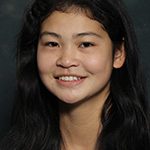 Emily Nishiwaki
Emily Nishiwaki
Current University: Cornell University, Chemistry
Prior University: Case Western Reserve University
Major: Materials Science and Engineering and Minor in Japanese
Status: Freshman
Expected Graduation Date: May 2020
Host Lab in Japan: Kyoto University – Dept. of Energy & Hydrocarbon Chemistry, Kageyama Laboratory
Research Project: “Exploring Zn-Based Visible Light Induced Photocatalysts” (PDF)
Why Nakatani RIES?
The Nakatani RIES program supports my cultural and language goals by giving me the opportunity to further my Japanese language skills and learn more about Japanese culture. What makes the Nakatani RIES internship special to me is how it’s a cultural experience in an academic setting. Beyond master’s school, I am unsure if I would like to look for a job in the materials science industry or continue my studies and pursue a doctoral degree. The Nakatani RIES internship will help me learn what I love to study and ultimately help me determine what role I want to play in the STEM community. I am looking forward to a summer where I can combine my passion for STEM research and Japanese language and culture.
Goals for the Summer
- Develop my Japanese speaking abilities
- Become comfortable in my host laboratory and be able to ask questions to conduct a successful project
- Apply what I have learned in the classroom to research
Meaning of Nakatani RIES (Post-Program)
When I was first accepted into the Nakatani RIES program, I thought it was too good to be true. I couldn’t comprehend the fact that I would be spending 13 weeks in Japan I would be able to learn Japanese, sight-see, and conduct research at a Japanese university as a rising sophomore. I spent this summer in Kyoto, working in Kyoto University’s Department of Energy and Hydrocarbon Chemistry. I was a member of the Kageyama Lab, whose main goal is to synthesize new materials with special properties such as ferromagnetism superconductivity, and photocatalytic activity.
I conducted research on visible light induced photocatalysts, which can be used to make the process of generating hydrogen energy much more economical and efficient. Specifically, I wanted to explore compounds with tetrahedral coordination and their potential as visible light induced photocatalysts. I chose a target compound of SrZnGaON and used two synthesis techniques in efforts to synthesize this compound; ammonia synthesis and high pressure synthesis.
My final results were somewhat ambiguous, but positive. The sample I obtained via high pressure had a significant color change (dark green to pink), indicating some sort of structural change from the original reactants. There was also a significant band gap change (~100nm). The new band gap of the sample is small enough to be a visible light induced photocatalyst, however, further testing (such as oxygen evolution test) need to be conducted.
This summer, I learned what it was like to do research in an incredibly prestigious lab. This research experience was a completely different than what I could have experienced in any lab in the U.S. By working in the Kageyama Laboratory I was able to learn what the culture of Japanese laboratory was like, as well as meet some amazing people who I strive to be like one day. What I noticed about the lab was how everyone seemed to be friends and always working together, whether it be helping out others how to use a machine to making sure the lab was clean.
Working in the Kageyama Laboratory was one of the most amazing experiences of my life. Everyone in the lab is incredibly smart, humble and kind. They never hesitated to help me with anything, regardless of how basic the question or task was. Despite how many mistakes I made, my mentor never got angry or impatient with me. The Kageyama Lab students are dedicated to their work, but also liked to have fun and joke around. Some of my best memories come from times with them – the lab barbecue was the best. Overall, I thoroughly enjoyed my research experience, from the research area I explored to the getting to know what the “research life” is all about. I’m now much more sure I want to pursue a master’s degree and even a PhD in the STEM fields.
When I wasn’t researching, I was doing my best to explore as much of Japan as possible. Being in Kyoto was the best because of all the history surrounding the city and its overall location in the Kansai region. I especially loved my day trip to the Shiga prefecture, where I saw Lake Biwa for the first time and walked around Enryakuji, located on the top of Hiezan. I also got to go to my first festival; Gion Matsuri was incredible. It was crowded and hot, but I went multiple days – it was definitely worth it! One night I even wore a yukata and geta, which was very cool, though my feet hurt a lot after. I went Gion Matsuri with other Nakatani students and some of the other students in my lab. I also loved being able to eat Japanese food everyday – I already miss Japan so much.
I know that in the future I would like to go back to Japan and build upon the experience from this past summer. Maybe I’ll be able to study there for graduate school! I am so happy and thankful for this truly unforgettable summer.
- My favorite experience in Japan was … going to Shiga Prefecture and seeing Lake Biwa and hiking around Hiezan and exploring the Enryakuji monastery and becoming friends with my amazing lab members.
- Before I left for Japan, I wish I had … studied more kanji (because you can never know enough).
- While I was in Japan, I wish I had … seen a big fireworks display. One day I want to go back and see the fireworks display over Lake Biwa during August.
Excerpts from Emily’s Weekly Reports
- Week 01: Arrival in Japan
- Week 02: Language Learning & Trip to Mt. Fuji Lakes
- Week 03: Noticing Similarities, Noticing Differences
- Week 04: First Week at Research Lab
- Week 05: Critical Incident Analysis – Life in Japan
- Week 06: Preparation for Mid-Program Meeting
- Week 07: Overview of Mid-Program Meeting & Research Host Lab Visit
- Week 08: Research in Japan vs. Research in the U.S.
- Week 09: Reflections on Japanese Language Learning
- Week 10: Interview with a Japanese Researcher
- Week 11: Critical Incident Analysis – In the Lab
- Week 12: Final Week at Research Lab
- Week 13: Final Report
- Follow-on Project
- Tips for Future Participants
Week 01: Arrival in Japan
After my last final finished Tuesday night, I left the next morning for the Nakatani RIES Fellowship pre-departure orientation in Houston. I was excited to meet the other Nakatani fellows and couldn’t wait for my summer to begin. Ice breakers were fun and I was relieved that everyone else was nice and also had loved science. I am also glad we participated in general lab safety training so I can go into the Kageyama Lab in 2(!) weeks with some knowledge about safety. After the serious seminar on safety, we had a fun seminar with Ozaki-sensei on Japanese culture, which I enjoyed. Then, we attended the welcome BBQ, which was the first time I ever ate real barbecue. More importantly, I got to talk to other people who are involved in the Nakatani program and get some last minute tips on how to have the best experience in Japan possible. On Friday, Professor Kono’s lecture on research in Japan was informative and made me less nervous about researching in Japan. I anticipated that working in a Japanese lab will be very different than an American one, and it was very helpful to hear from Professor Kono how I can adjust and learn as quickly as possible. I also loved walking around the Rice campus, which I am incredibly jealous of. The last part of the orientation was a presentation by Sarah, which was helpful to make sure I’ve taken care of all the logistics I can before leaving for Japan.
Before the Nakatani program began, I was nervous about the language barrier, cultural differences, and my ability to contribute in my lab. I knew that many people spoke a bit of English, but I didn’t want to rely on that. After a year of Japanese, I have made a goal for myself to improve my Japanese as much as possible and to be able to comfortably get around and ask for help. However, once we arrived at Narita Airport, I wasn’t sure how I was going to achieve this goal. The airport was a swirl of kanji and everyone was speaking so fast, it was hard to tell it was Japanese. I was also extremely self-conscious about my mannerisms, how loudly I talked, and if I was in the way. Maybe to some, I could pass as a native Japanese citizen, but once I open my mouth it becomes blatantly obvious that I am definitely a foreigner. This past week, I have been “observing” so I can learn as much as possible about how to adapt to Japanese culture
The first thing I noticed about Japan was how clean and organized it was. Despite Tokyo being a densely populated city, there was no trash in public anywhere. I also noticed that though there are so many subway lines, it isn’t too hard to navigate the because there are signs everywhere. The convenience stores are also amazing! It has been a challenge, but I have also been trying to “put myself out there more” to improve my Japanese by asking for others for help and completing transactions in Japanese. My struggle with the language barrier is what I expected, though it is not bad as I thought. When I can’t convey what I want to say in Japanese, people are kind and speak in English. With broken “Japanglish” on both ends, things work out. I’ve learned that good intentions and effort can go a long way.
Language class is long, but I am learning a lot. This summer, I think I should focus on speaking and listening comprehension, which fortunately, is what class is focused on. I’ve learned that I am able to comprehend slow, controlled structure and grammar speech, but when it comes to faster and casual style speech, I struggle. I think the faster recordings we listen to in class will help me improve. As for speaking, the free flowing periods of conversation between teacher and students are helpful. We are learning a lot of grammar in a short amount of time, which is difficult. However, I think if I try to use it outside of class I will be able to absorb it quickly. Interestingly, we have not covered kanji in class yet. However, I think this makes sense, since Yakub, Will, and I are all at different levels when it comes to kanji. To learn kanji, I’ve been trying to read all the signs I can and to make a few designated kanjis “kanjis of the day” in my notebook. For example, I’ve learned plum I’ve been remembering them by their radicals, which is helpful. Overall, I’m doing my best to learn Japanese by speaking to people even when I’m nervous and uncomfortable, trying to read everything I can out when I’m out and traveling, and listening to announcements (on the train).
I had a lot of fun speaking to the Todai students after the tour of the lab tours. It actually turns out that one of the students and I like the same band, Sukima Switch! I have never heard of anyone but me liking it and we were both really surprised that we had that interest in common. From there, we talked about American and Japanese music: what was popular and the similarities and differences. The student I spoke to didn’t speak a lot of English, which made great practice of how to communicate and overcome the language barrier.
My favorite seminar of the week was the presentation on Current Japan-China Relations and the Trump Administration by Shikata-san. I think he presented very well and simplified very complicated issues into a way that many people could understand it. I actually understood the situations he presented very well, but when we were asked to come up with potential solutions, my whole table was stumped. I also really enjoyed learning about the Trump administration and the TPP from a Japanese perspective. It was sad to hear that many countries, including Japan, are ready to move forward with their plans without the US, seeing it as a lost cause. After this seminar, I am more interested in learning about Asian relations and politics. It’s incredible how important international relations are to a united global community and I’ve decided that I definitely want to keep up more with world affairs. I also got Shikata-san’s autograph, which was my first autograph from a celebrity (even if he isn’t a singer or anything).
After this first week in Tokyo, one question I have about the culture is how present gender stereotypes are still within society. I went to ultimate Frisbee practice and I was talking to one of the players, who was probably in his 30s. I told him I was here doing materials science research and he actually said Japanese, “A girl? In materials science?”. Maybe he thought I wouldn’t understand it with my level of Japanese. He didn’t say it in a derogatory way either; I think he was just genuinely surprised. I think the only way I can answer this question is to observe and talk to more people, whether it be other ultimate players in Kyoto as well as people in my lab. I think the lab environment can tell me a lot about the gender stereotypes that may be present in Japanese society.
These are three pictures that I believe best capture this week. The first picture is the amazing green tea parfait I had with Rose, which was before we sat outside next to the SkyTree. It had warabi mochi, green tea jelly, green tea ice cream, waffle bits, red bean, and white cream. We want to go back before I leave for Kyoto, hopefully with some other people! Overall, this pictures reminds me of a great experience when I got to eat an amazing Japanese dessert and become better friends with Rose. The second picture is a picture from the Imperial Palace. This was one of the many amazing parts of the grounds. My walk around the grounds was refreshing and introspective, which I needed after a busy week. The third picture is a picture from the Grand Sumo Tournament we went to, which was a lot more entertaining than I thought and unexpectedly fun to watch with everyone.
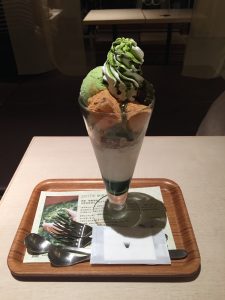
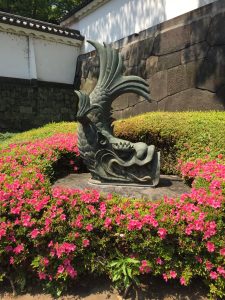
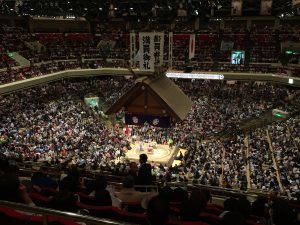
Research Project Introduction and Article Overview
The tour of the Tabata Lab at the University of Tokyo was incredible and only made me wonder how amazing the Kageyama Lab at Kyoto University will be. The lab itself was big and the equipment was impressive. I think this was my favorite research-based tour/talk because it gave me a sense of what kind of environment I will be in. I also got to see some of the equipment first hand and some demonstrations, which I think will be helpful for when I have to use equipment such as x-ray diffractometers for my own research by myself.
At this point, I believe that I will be researching mixed oxyanion catalysts for visible light reactions, such as splitting water. The splitting of water into H2 and O2 gas is a thermodynamically not favorable since it is an endothermic process. However, with the help of a catalyst, this process can be done, which is a way renewable energy can be generated. What would make the best renewable energy process would be if this catalyst could work with visible light. Ideally, when visible light, or photon energy is absorbed by the material, electrons are excited and are able to be reduced and oxidized to produce H2 and O2. To find an appropriate photocatalyst, a material with a band gap energy smaller than 3 eV, correct band edge potentials, and the ability to be stable in a photocatalytic reaction must be discovered. Making progress toward this goal will be the crux of my research.
One paper I read from the Kageyama Lab was a paper by my graduate student mentor, Kato-san, Valence Band Engineering by a Layer Insertion to Sillen-Aurivillius Perovskite Oxyhalides. This study investigates Sillen-Aurivillius type compounds, which are compound with a specific chemical structure. These compounds are special because they can potentially engineered to a favorable band. Specific compounds were investigated and their crystal structures were determined to determine the effect of the inserted alkali-metal halide layer on electronic and optical properties. Powdered forms of these compounds were prepared with an x-ray diffractometers and scanning electron microscope. Overall, this study shows that by modifying the structures of Sillen-Aurivillius based structures, the band gap, and thus the effectiveness of the photocatalyst, can be improved.
Article Citations
Daichi Kato, Cecile Herve, Takafumi Yamamoto et. al. “Valence Band Engineering by a Layer Insertion to Sillen-Aurivillius Perovskite Oxyhalides”. Chemistry Letters. http://www.journal.csj.jp/doi/10.1246/cl.170301
Kageyama Lab Published Articles: http://www.ehcc.kyoto-u.ac.jp/eh10/index.php?lang=en&page=%E8%AB%96%E6%96%87%2FPublications
Week 02: Trip to Mt. Fuji Lakes
I definitely can’t say that I have gotten used to Japan, but I am definitely more comfortable. My language class has had a lot of fun, interesting conversations. Compared to last week, it has been easier to hold casual conversations and I am able to complete simple transactions without having to mentally rehearse what I am going to say beforehand.
When the group first arrived in Japan, we went to a local ramen restaurant in Azabujuban. That night, I ordered in Japanese, but the waiter switched to English when he realized I was not a native speaker. I went back with Rose earlier this week and I was able to speak to the waiter entirely in Japanese, and he didn’t switch to English! I am happy that my speaking abilities, as well as my ability to fake my ability in Japanese, is improving. I hope that with this last week of language class and my conversations with new people I can begin to use more understandable and complex grammar in everyday conversations.
That being said, my Japanese abilities still have a long way to go. I have trouble understanding faster, native speech. I attended a Japanese club meeting that my friend took me to and played in a Frisbee pick-up game and was fairly lost throughout both of them. I hope with due time, I will be able to understand bits and pieces in situations like those as well. Right now, I can’t foresee that being possible. However, I think I underestimate the power of simply being immersed in a country of people who speak Japanese. Especially after going to Kyoto and being around very few English speakers, I hope that my conversational abilities will start to improve even faster than they are now.
Overview of Mt. Fuji Lakes Trip with 2017 Nakatani RIES Japanese Fellows
My experience in Japan has entirely been in cities; this weekend was the first time I got to see Japan’s nature. The drive through the Kanagawa and Shizuoka prefectures was gorgeous and I spent a majority of the bus ride looking outside the window at the beautiful green sea of trees and mountains that surrounded us.The view from the Mishima Skywalk, Kitaguchi Hongu Fuji Sengen Jinja, and of course Mount Fuji’s 5th Station itself was breathtaking and I hope I can go back some day.
The US andJapanese Nakatani Fellows met for the first time this past weekend on a trip to the Mt. Fuji Lakes. I didn’t expect to enjoy meeting the Japanese fellows as much as I did; I was very sad to say good bye to them on Sunday. I ended up talking to the Japanese fellows much more than the US fellows about everything from favorite foods to really bad pick up lines you should never use. I particularly enjoyed learning about the different dialects of Japan from the fellows such as Aomori-ben and Hiroshima-ben. I made sure to pick up various Kansai bend phrases in hopes that I will be able to understand a little more Japanese when I get to Kyoto. By learning about the different dialects with Japan, I realized the differences that exist between the regions in Japan. Within the United States, I don’t think that there are a lot of regional differences in English. The dialect phrases I learned were very different from each other, and many of the Japanese fellows didn’t recognize each other’s phrases from their respective regions.
The biggest challenge of this trip was going to the onsen. I am glad that my roommates, Kaylene, Miki, and Ayaka encouraged me to go. Though I was uncomfortable, it was relaxing and I can now say I overcame a significant cultural difference that I was particularly apprehensive about. In hindsight, I realize that since going to an onsen is part of Japanese culture, there is no real reason for me to be uncomfortable since everyone around me thinks it is normal. I would go to the onsen again, but I definitely would have to be encouraged by others.
One interesting thing I noticed was how within the Japanese fellows, the girls and guys tended to group and only talk to each other. I’m not sure if this was just a coincidence, but it was definitely different than the dynamic within the US fellows. Kaylene and I talked to Miki and Ayaka Saturday night about the gender stereotypes and dynamic between males and females in Japan. I knew that they were a little more antiquated than US’s, but I was still sad to have my knowledge confirmed from native Japanese students. I am not sure if Japanese gender culture is related to the dynamic within the Japanese fellows, but it is definitely something to think about.
Question of the Week
Going off of this, one question I have is why these immense differences in Japanese language exist. How are the Kansai, Kanto, Chubu, etc. regions defined and how do you know which prefectures belong to which?
- Japanese Dialects (Wikipedia)
- 7 Major Japanese Dialects you Outa Know (Fluent U)
- All You Need to Know About Japan’s Weirdest Dialect – Tohoku-ben (Tofugu)
- Deciphering the Dialects of Japan (Gaijin Pot)
- Opening Up to Difference: The Dialect Dialectic (Japan Times)
- Kansai-ben: Self-Study Site
- Some Handy Phrases so you can Speak the Kansai Dialect (Japan Today)
- Kansai vs. Kanto: Japan’s Most Bitter Feud (CNN)
Overview of Week Two Orientation Program in Tokyo
The most interesting Introduction to Japanese culture seminar was the Kimono workshop by Ito-san. Before his presentation, I did not know anything about the history and cultural importance of a kimono besides that it is worn on special occasions. I was fascinated by the process of making the kimono and the rituals of how the kimono gets passed onto the new emperor. I also am looking forward to the 2020 Olympics and seeing the country-themed kimonos that Ito-san is working on. I also enjoyed talking to some Todai students about questions we have about each other’s cultures. We began by talking about why there are so many convenience stores and vending machines (they didn’t know), but it eventually evolved to a fun conversation about our favorite pokemons.
Below are 1-3 pictures that best describe this week. The first one is a picture of Mount Fuji taken at the Kitaguchi Hongu Fuji Sengen Jinja. It was my first time seeing Mount Fuji and it was a lot bigger and amazing than I imagined.
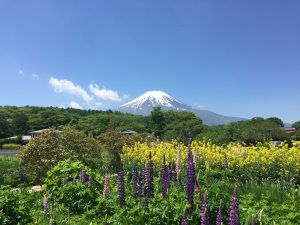
The second picture is a picture from a dinner with my friend. It was my first time eating monja, a Kanto-region specialty. Once you order, a bowl of raw ingredients is brought to you; you are supposed to cook your own monja at your table. I learned how to make monja, which was surprisingly difficult, but worth it.
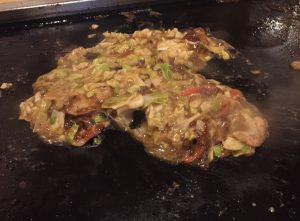
The third picture is the iconic Shibuya intersection. I don’t think my trip to Tokyo would have been complete without visiting Shibuya, and I’m glad I got to do it with the rest of the Nakatani fellows.
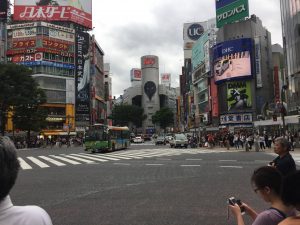
Introduction to Science & Engineering Seminar
For our Introduction to Science and Engineering seminars, we listened to two lectures by Professor Kono and one by Kawata sensei. I found Professor Kono’s lectures very helpful because they outlined the basics of what I need to know for understanding my papers. Part of it was review from a class I took this past semester, such as the electrical conductivity of semiconductors and metals and band gaps. It was also my first real encounter with quantum mechanics, which was quite hard to grasp. Professor Kono also talked about carbon nanomaterials and their applications, which I previously have had no knowledge on, but found it very interesting. From Professor Kono’s lectures, the material that will apply most to my research was about how band gaps can be reengineered. I’m glad I understood most of what he was talking about in that topic – maybe I will be going into lab next week somewhat prepared! However, I’m still reviewing the material Kageyama-sensei sent me. I’m noting the main processes and basic concepts that the lab’s research is centered around, such as the use of x-ray diffractometers, the parameters necessary for engineering a proper visible light photocatalyst, and the applications of such catalysts.
Kawata-sensei addressed his research and his areas of interest, but what I particularly took away from his lectures was his message on how interdisciplinary science is becoming. He joked that someone cannot become an expert on every topic; rather, many people from different fields will have to work together in order to make new discoveries. This really spoke to me and reminded me why the Nakatani program is so amazing. This summer, I am going to be doing research in Japan and learning about a whole different research culture. I get to meet other researchers from around the country, as well as around the world and hopefully make life long friendships. I can’t wait to make the most of this summer!
Week 03: Noticing Similarities, Noticing Differences
These past three weeks, I have progressed from not wanting to ride the subway alone without a map to being comfortable with getting around to a majority of places in Tokyo (with prior research). As I grew more comfortable with the subway, I stopped worrying about whether I was on the correct line going in the right direction and started to observe the atmosphere of the metro itself.
The first thing I noticed about the Tokyo subways that they are close to silent except for the announcements telling passengers watch out for the closing doors and the next stop. At most, people talked to one another in low voices; I never heard a single cellphone ringer go off. Most people are preoccupied by listening to music, using their phones, or with a book. Toward the end of the day, there are many people going home from their jobs and use the time to take a nap. I have also noticed that people do not eat or drink on the subway. Maybe this explains the cleanliness of the Tokyo subway system. I do not understand how something that accommodates so many people and operates for the majority of the day, seven days a week, can be cleaner than my college dorm.
Being from a suburb of New York City, I am fairly familiar with riding New York’s subway. The only thing that they have in common is that they are extensive and somewhat confusing. Before you get on a train in Tokyo, there is a generally widely used rule to let other people get off the train before others get on. However, in New York, sometimes people are in such a rush that exiting and entering becomes a bit chaotic. The NYC subway is generally louder, with music leaking from people’s earphones, groups of people talking and laughing, and sometimes people walking through asking for money. It it has been interesting to see how two major city subway systems could not be more socially different.
On the Tokyo subway system, people take up only one seat and make sure they keep their bags either on their lap or in between their legs. Most trains I have taken are not crowded, but there was one time when I went to Shibuya around 5:30. The train was packed, and everyone had taken off their backpacks and placed them on the ground to accommodate as many people as possible on the train. This consideration is not only practical, but reflects Japanese cultural value of consideration for others. Even if someone is in a rush, it is still more important to make sure that you do not disrupt other people’s lives and make them uncomfortable in their travel to their destination. Furthermore, the fact that people take great care to keep the subway clean shows the concern for the well-being of the community. Going back to the Japanese cultural values we learned about during pre orientation in Houston, I think the subway etiquette I have observed corresponds to “harmony”. Though there are not spoken rules, there seems to be a general understanding among Japanese citizens on how to make the commuting as efficient and simple as possible. Subway etiquette can also be tied back to “effort”; everyone on the subway recognizes the effort an office worker has put into their work that day and respects that by being quiet and letting them have a peaceful commute home.
Overview of Week Three of Orientation Program in Tokyo
I particularly enjoyed the cultural topics discussed in the seminar which focused on the evolution and current state of the perception of women in Japanese society. Saeki-sensei gave a seminar on the history of the perception of women in media. The shows that she discussed were a bit strange: one was about a woman who kept a man as her pet. I learned that the perception of women shifted from “a woman can achieve happiness with a rich and good-looking husband” to “a woman can achieve happiness with a supportive and caring husband”. This really speaks to the fact of how women have begun to seek a more equal role in society to men and how rapid changes have been made in the past 40 years. Women are not only seeking to be married and be “part” of their husband, but as someone who plays an active role in her own life and looks for support as she navigates her way through it.
Despite these developments, Japanese women are still severely underrepresented in STEM fields. Ishioka-sensei’s lecture about perovskite’s use in energy research was fascinating because I believe I will be using perovskite in energy research (though a different type) as well! What was just as interesting to me were the statistics she shared about how she is a minority in her field and citing what about Japanese culture causes girls not to go into STEM fields. Ishioka-sensei is a role model for Japanese girls who want to pursue a STEM field and also for me, as an aspiring materials scientist.
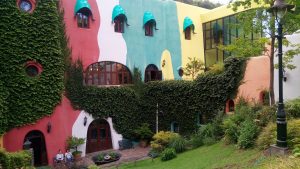
The last day before everyone left for their respective museums, a group of us visited the Ghibli Museum! Unfortunately, pictures were not allowed inside the museum. It was a small museum with my favorite exhibit being the special showcasing of how food was animated in many of the Ghibli movies! This is one of my favorite museums ever and I’m glad I could have a chance to visit while I’m in Japan.
The Ghibli Museum is a little outside of Tokyo in Mitaka. On the way there, Josh and I ran into an organized protest of the royal family. At first, we thought it was a parade, but quickly realized the marchers were too angry and with my Japanese knowledge, I knew they were yelling that they “didn’t have something”. Fortunately, we were standing next to a woman who spoke English and Japanese and explained the situation. It didn’t sound like she knew much about why they were protesting either. Many of the other Japanese people around me looked relatively impassive and neutral about the protest as well; I’m wondering how major this issue is.
Question of the Week
One question I have about Japanese culture at the end of this week is the role and presence of the Royal Family. I went to the Ghibli Museum this past weekend. The museum is a little outside of Tokyo in Mitaka, and on the way there Josh and I ran into an organized protest of the royal family. At first, we thought it was a parade, but quickly realized the marchers were too angry and with my Japanese knowledge, I knew they were yelling that they “didn’t have something”. Fortunately, we were standing next to a woman who spoke English and Japanese and explained the situation. It didn’t sound like she knew much about why they were protesting either. Many of the other Japanese people around me looked relatively impassive and neutral about the protest as well; I’m wondering how major this issue is.
- You may want to consult Google-sensei and in particular search on English-language news sites such as Japan Today or the Japan Times where you may find more of a local perspective on the issue.
- Right now, there is some controversy as the Emperor is seeking to abdicate in favor of his son but also questions about the longevity of the royal family line since, in Japan, only male heirs can inherit the throne but right now there is only one male child who is eligible as the Prince and Princess only have one daughter. Some are calling for changes to allow female heirs to inherit the throne as well. To read more see:
Photos of the Week
Below are three photos that I believe best represent this week. The first one is a picture of a gyoza dinner that a group of the Nakatani fellows had in Harajuku. It was cheap, really good, and fun to explore a bit of Harajuku together.
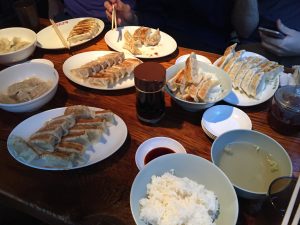
The second picture is the Hozomon Gate at the Sensoji temple. The Sensoji temple was beautiful and I really enjoyed walking around the area, but I also loved the surrounding streets selling a variety of goods and foods. After walking around here, Asakusa has become one of my favorite parts of Tokyo!
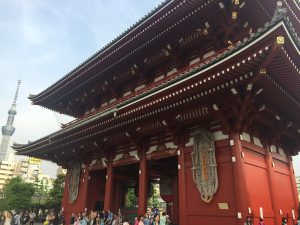
Introduction to Science & Engineering Seminar
Most of the material covered by Professor Stanton was unfamiliar to me. He covered the basics of band gaps, semiconductors, and LEDS. This was particularly helpful because understanding band gaps is pertinent for my research in the Kageyama Lab. Though it has nothing to do with my research, the most interesting aspect of his lectures was femtosecond lasers and their applications. I’m finding more and more that I love learning about topics that I never knew existed!
Professor Futaba from the CNT Application Center came to talk about his research on carbon nanotubes and his experience as a Japanese-American working in Japan. I appreciated that he started from the very basics of carbon nanotubes and their applications, and then moved onto what his research is focused on. Overall, I really enjoyed Professor Futaba’s lecture; I hope I can learn more about carbon nanotubes in future courses I take. On the cultural side, I also enjoyed hearing about his experience as a Japanese-American working in Japan. In a turn of events, I could be in a similar situation as Professor Futaba, and I found it helpful to hear about such a unique experience.
I would like to know more about how exactly x-ray diffraction works, since this is a process I will be doing to examine the structure of various synthesized materials. I would also like to understand how different structures of compounds play a part in the band gaps and stability in solid solutions. Hopefully I can speak with my mentor once I get to lab this week and clear up my confusions.
Return to Top
Week 04: First Week at Research Lab
My first day at the Kageyama Lab was close to being the complete opposite of my expectations. For one, Kageyama-sensei was not at all like the strict, Japanese professor I expected to meet; rather, he was energetic and kind. Secondly, almost immediately after I arrived at the lab, I was driven by Kageyama-sensei to a local softball field for a departmental softball tournament. Funnily enough, this helped me learn everyone’s names by associating them with their respective positions on the field. I was also extra nervous because everyone knows I play softball, and they were expecting me to be an “MVP”. Overall, the game was really fun, though it was slightly disappointing; after seven innings the game was still tied, so the game was decided by rock-paper-scissors, to which we lost. This was made up by the fact that everyone found out that Kageyama-sensei is extremely good at baseball and even dove back into second base on a close play.
I couldn’t ask for a better mentor than Kato-san. His patience is endless; even when I forget how to use the XRD program or how to turn off and on the NH3 and N2 gas, or even take three times as long to measure out compounds to their precise amounts, he doesn’t get angry or annoyed. I can tell that it takes a great amount of effort for him to use English, and I really appreciate that he wants to make sure that I understand the work that we will be doing. I also worked with two others this week, Ikeuchi-san and Nakashima-san, who taught me how to use the high pressure synthesis machine and how to make a synthesis cell.
Everyone in the Kageyama lab speaks some level of English. I speak to the other international students in the lab in English. Many of the Japanese students also speak English well, though many of them are too shy to use it with me. I can relate to this feeling when it comes to Japanese. I hope to build up my confidence of using Japanese with them, and maybe they will feel more comfortable talking to me. To my relief, I do not think my Japanese abilities will impede me from conducting research this summer because both Kato-san and Kageyama-sensei can speak English. However, my low Japanese abilities has made it harder to get to know the other students, though I hope with time, things will change.

My housing is spacious and had many essentials were provided to me when I first arrived. The commute to lab is around 50 minutes, where I take the train and bus to west Kyoto. Kyoto University’s Katsura campus is only 12 years old; the facilities are clean, new, and the campus itself has an interesting and efficient layout. The campus resides in what begins to be a mountain region. I’m surrounded by mountains and I can see Kyoto below me. It is such a privilege to be able to work on such a well equipped and beautiful campus.
Coming into this summer, I was unsure that I would enjoy solid state chemistry research and did not know if I would be able to handle an intense lab environment. I made numerous mistakes this week, such as ruining one of my samples (that I will have to re-do on Monday) and tearing a little hole in the glove of the glove box. This Friday was also special in that the Kageyama Lab had a Kenso, an all-day meeting where everyone presented their research from the past month. Given that I had only been in lab for four days, Kageyama-sensei asked me to give a short self introduction (in Japanese) and a general overview of what I would be doing this summer. This was a small task compared to all of the other students, but I still was incredibly nervous and spent most of the morning and early afternoon with my stomach churning and having minor panic attacks. Despite my mistakes and anxiety, I really enjoyed this past week at the lab and am looking forward to what is in store for next week. I’m excited to be able to become more independent and (hopefully) help the Kageyama lab in any way I can.
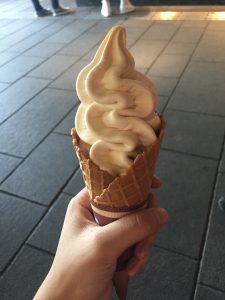
On Tuesday, Kageyama-sensei asked me to eat lunch with him. The lunch was casual, where we talked about American and Japanese culture and the history of the lab. I have heard from other students that Kageyama-sensei is incredibly busy, so I was especially surprised that he wanted to take time to eat with a B2 intern. What particularly struck me about Kageyama-sensei was how during our first meeting the day before, he bluntly asked if I was nervous, to which I responded, “very”. He then told me to not be afraid; research is a place to make mistakes. He continued with that despite me being inexperienced and only here for a short time, that he believes that I can help the visible light photocatalyst group within the lab. I’m unsure to what extent he actually believes this, but I am grateful that he is supportive and willing to develop a personal relationship with his students. Moreover, he called his lab a family, and encouraged me to ask others any questions I have to the other students. It has been hard to interact with the other students with the language barrier and my shy personality, but I hope in the coming weeks I can get to know them all better.
After the busy week, I had a really fun weekend. I met up with Erica, an American 2016 Nakatani Fellow from last year! We went to the Fushimi-inari shrine and had dinner in the Kawaramachi area. I also went to Arashiyama with the other Nakatani fellows who are in Kyoto (Kaylene and Alex) as well as Savannah, Will, and Katelyn who came to visit. I loved Arashiyama and I definitely want to go back. I also tried kinako ice cream for the first time, which Kaylene and I fell absolutely in love with. Previously, I had only had kinako on mochi, and this was even better! There was also a yuba-flavored ice cream that I want to try when I return at some point during the summer.
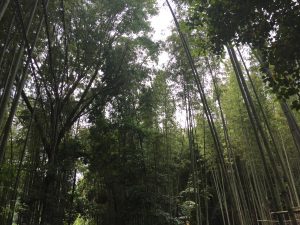
Reflection on Orientation Program in Tokyo
The orientation program was a whirlwind. I learned new Japanese grammar patterns, kanji, and basics of modern physics. There were so many grammar patterns that I only use 4-5 in conversation. However, I am able to recognize the grammar when listening to it; during our all day meeting this past week for lab, I was able to decipher some of what the other students were saying!
After the orientation program, I learned that I like to plan ahead. Whether it be to figure out how many kanji I want to learn a day, what subway lines I want to take where to save the most money, or doing research on the internet to find best matcha ice cream in the area. Hopefully, I can use my “planning-ahead skills” in Kyoto to maximize my research and sight-seeing experience.
Besides questions that arise from my confusion in lab, the biggest questions I have about Japan right now is how to use the Kyoto bus system. Part of my anxiety about buses is due to the fact that I do not have a lot of experience with them. However, since Kyoto’s bus system is also very extensive and to get to many places I would want to see, I want to utilize it to its full extent. I think the only way I can get comfortable with buses is to use them and get lost, though the prospect of that is a bit scary. Hopefully, next weekend I can go sight-seeing with Kaylene, Erica, or Alex and we can help each other navigate!
- Kyoto Visitors Guide: Transportation
- Taking a Bus in Kyoto
- Kyoto Buses
- Also, if you want to try your hand at taiko again, check out the Kyoto Taiko Center
Research Project Update
Right now, it is clear to me that our goal is to synthesize a new material to create a visible light photocatalyst. Specifically, I will be working with Kato-san on synthesizing a solid solution of ZnO and GaN to develop a compound with a small enough band gap to act as a visible light photocatalyst. We will be synthesizing this compound with NH3 reaction and a high pressure reaction at various reaction conditions. Currently, we are using SrO as the starting compound to synthesize Sr(Zn(1-x)Gax)O(2-x)Nx. This coming week, I expect to continue tests using the following reaction:
SrO + (1-x)ZnO + xGaN àSr(ZnGa)ON
However, I am not sure what direction this project will take once these tests are finished. I expect that to become clear soon, once I talk to Kato-san and read more about my research field.
I will be using a glove box, x-ray diffractometer, furnace, and high pressure synthesis machine this summer. The glove box will be used to prepare air sensitive samples in a controlled environment. I think after a week I understand the process of taking things in and out of the glove box such to keep the air inside purified. However, I still need more practice when it comes to working with compounds inside the glove box; measuring exact amounts of sample with three pairs of gloves on is something I am not naturally good at.
I will also be using an x-ray diffractometer to analyze the lattice parameters and the impurities contained in the samples. If the experimental XRD matches the ICSD graph, then we have successfully substituted an anion into our solid solution, which therefore lowers the band gap. Impurities are measured by analyzing anomaly peaks. I still am learning how to use the program, but Kato-san has told me I will be using it a lot; by the end of the summer, hopefully it will become second nature. Finally, I will be using a high pressure synthesis machine and a furnace for ammonia synthesis reactions. Similar to the x-ray diffractometer, with due time, I think I will be comfortable using this piece of machinery.
I am really looking forward to this week and overcoming the new challenges that will (inevitably) arise. I plan to read as much of the solid state chemistry textbook that Kato-san lent me as well as make a power point summarizing everything I’ve learned so far. I’m also going to try to get to know my fellow lab students more and am excited to practice my Japanese with them!
Week 05: Critical Incident Analysis – Life in Japan
It had been a long day at lab, with me sitting at my computer, compiling and analyzing data all day. I was struggling to make sense of the past week in Powerpoint for Kato-san and Kageyama-sensei, who I would be presenting to later that week. I got up to stretch my legs a bit and saw that one of the other students also looked tired, his eyes a bit glassy and he was gazing out the window. Upon seeing him, I remembered the night before that I had been looking into things to see around Lake Biwa. This student is from Shiga Prefecture, so I figured it wouldn’t hurt to ask him for some recommendations and advice. I sat down and we talked for a bit about Lake Biwa and some nice sites, and eventually, our conversation went like this:
“I’m thinking of going to Hiezan. Have you been there?”
“No, I haven’t, but I’m thinking of going next month with my friends and some people from lab! There is a beautiful fire flower festival.”
“That sounds great! Maybe I will go for the festival too.”
“Will you go with anyone?”
“I’m not sure, probably not. I don’t know a lot of people in Kyoto.”
“………”
“………”
And from there, I awkwardly brought up a different topic. I’m not an expert on social interaction, but in my opinion, that was a pretty awkward way to end a conversation, at least in an American sense. Among my friends at college, we would probably just invite the other person, or give an explanation why it wouldn’t be a great idea to invite the other person and suggest alternatives. I’m not sure if the reason the conversation ended like this was because we are awkward, the language barrier, and/or in a Japanese-sense, the ending of this conversation was perfectly normal. Perhaps in my American mind, I was expecting a different outcome, or at least a more definitive one, from this conversation. The student definitely had good intentions, recommending me places to see and overall, our conversation was enjoyable. However, this part of our conversation particularly puzzled me.
Since then, this situation hasn’t been resolved. I don’t talk to this student that often, and when we do, it’s not about our weekend plans. I hope I can figure out why our conversation ended this way and also find some people to go to the festival together. I also hope that along with this student, I can get to know other lab students better. Things are starting to change already, even with this awkward encounter; on Thursday, I went out for Chinese food with a few of them, which was really fun. We also have a lab barbecue next week that I’m really looking forward to!
This past weekend, I went to Uji with Kaylene and saw Byodoin and Mimurotoji! Mimurotoji may be my favorite temple that I’ve visited. Though the area was crowded, the landscape was absolutely gorgeous, and the shrine was impressive. From some research, I read that in June, Mimurotoji is known for its hydrangeas – as soon as we got there, I saw why. The entire hill, with the temple at the top, was a sea of hydrangeas. I also enjoyed walking down Byodoin-omotesando, where the aroma of green tea lingered all the way down the street.
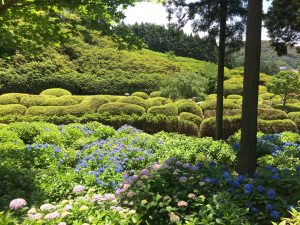
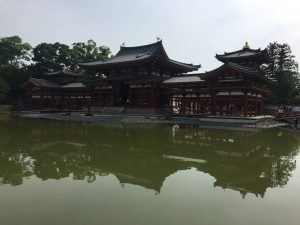
I also went to a women’s Frisbee practice this past Sunday. I got up at 6am and didn’t get back until 5pm; it was certainly an experience. Everyone’s English was probably a little higher than my Japanese; it was very hard to understand the explanations of the drills, and thus I just ran around being confused for good parts of the practice. However, everyone was also nice and willing to converse with me in Japanglish so I could understand what we were doing. Aside from the actual drills and Frisbee techniques I learned, it was nice to see how a Japanese ultimate Frisbee practice was run in comparison to ones in the US. I do wonder why the practice needed to go from 9-5; it seemed like the same amount of work could have been completed in maybe 3 hours. As an American, it seemed too long, but perhaps with more reflection I will see another perspective.
Research Project Update
This week, I continued to try various methods of synthesizing a solid solution of Sr(ZnGa)ON. Last week, we saw the reaction of SrO + ZnO + Ga2O3 is unstable in an NH3 synthesis reaction at 800°C for 5 hours, producing Sr(OH)22H2O. This week, we tried this reaction again under a new set of conditions. Kageyama-sensei advised Kato-san and I to try heating the sample to 1000°C degrees and then lowering the temperature to 850°C after 2 hours. We synthesized the same reaction with modified conditions but unfortunately, an XRD matching Sr(OH)22H2O was produced. We are going to try to synthesize this reaction at 750°C and hope that we can synthesize the solid solution successfully.
Another option for the synthesis of ZnO-GaN is to raise the temperature and pressure applied on the sample. This time, I combined SrO + ZnO + GaN, put it into the high pressure machine, and analyzed the sample’s lattice paramters with an x-ray diffractometer. However, the changes in the lattice parameters were ambiguous, and we could not conclude whether Sr successfully substituted into the ZnO-GaN solid solution.
Kato-san and I discussed a slightly different approach to the high pressure technique. Next week, I will be using high pressure synthesis to synthesize the solid solution of ZnO and GaN first, and then synthesize that solid solution and SrO together in another high pressure reaction.
This past week, I also investigated the lattice parameters of the solid solution of (ZnO)(1-x)(GaN)(1-x) at x values of 0.0, 0.1, 0.3, and 1.0. For the synthesis of x = 0.1 and 0.3, NH3 synthesis with reaction conditions of 850°C and 5 hours. I used an x-ray diffractometer and the Topas software to calculate the lattice parameters of all the respective solid solid solutions and generated a graph to analyze the data. However, instead of obtaining a linear, monotonically decreasing graph, I got something very different. After reading a few papers, Kato-san and I realized that it is impossible to use NH3 synthesis to make a ZnO-GaN solid solution with Zn content of over 0.7. My results reflected this; in the cases of x = 0.1 and 0.3, a compound with similar lattice parameters to just GaN was produced.
Kageyama-sensei also advised me to try a new method of synthesizing SrZnGaON. I first plan to prepare SrZnO2 with SrCO3 and ZnO. These are the same starting as before, except I will be using a temperature of 1200°C to attempt to lessen the impurities after the synthesis. Then, I will be preparing SrGaO2.5 by SrCO3 and .5Ga2O3 at 1400°C for 10 hours. Theoretically, these compounds can be combined into the solid solution of Sr(ZnGa)ON. Lastly, I also plan to try to synthesize a completely different solid solution of LaZnON to compare it with SrZnGaON.
Week 06: Preparation for Mid-Program Meeting
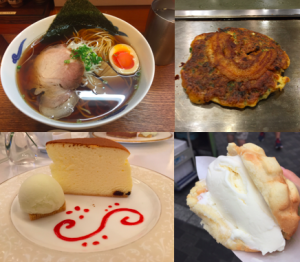
This past weekend, I did a lot more traveling than I ever expected to do in a weekend. On Saturday, Erica, a 2016 Nakatani fellow, and I went up and down the east side of Lake Biwa, the largest lake in Japan that covers 1/5 of Shiga Prefecture’s total area. I got to see the lake and a few surrounding temples and shrines on a relatively clear day, especially for rainy season! I also met my Japanese professor and some students from my home university, Case Western Reserve University, when they were in Osaka. We ate and walked around the city and talked about our various experiences in our language exchange programs, internships, and jobs. My Japanese professor’s hometown is Osaka and she showed us a few of her favorite places to eat, as well as bustling shopping and restaurant areas.
To make all this traveling cheaper, I bought something called the Kansai Thru Pass, which allowed me to save ~1500 yen! Getting this pass was a big challenge. Because Erica and I decided our plans relatively last minute, I had to go get the Kansai Thru Pass before I went into lab last Thursday, which required me to take a bus to Kyoto Station. I am very inexperienced and bad at using a bus to get around, let alone when all the signs and announcements are in Japanese. It definitely didn’t help that the bus station that I was supposed to start at has 7 different stops scattered at various places in the intersection. That Thursday was a whirlwind of me going in the wrong direction, asking for directions and using almost all of my precious 110MB of data with Google Maps (I probably looked like I was playing Pokemon Go).

However, that stressful Thursday was more than worth it. To get to Enryakuji, a Tendai Monastery on the top of Hiezan, Erica and I took a cable car up the mountain, which provided excellent views of the mountain area and Lake Biwa. We walked around the various areas of Enryakuji all morning and then headed north to see a much smaller temple, Mangetsuji, which is probably one of my favorite temples I’ve ever been to. Since it is out of the way for most tourists, Erica and I were one of the only ones there. We sat and relaxed on Ukimido, “the floating pavilion”, and admired the lake as we recovered from the hours of walking we did at Enryakuji. Afterwards, we went to Otsu, the capital of Shiga, and experienced a much quieter, different side of Japan than we were both used to, as well as stayed until sunset to see the Otsu flower fountain light up in various colors.
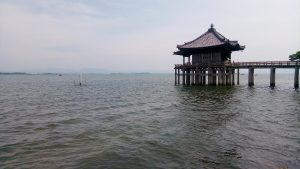
In addition to an amazing weekend, I had a pretty nice Friday as well! Kyoto University held a welcome dinner for international students, where I got to talk to some other international students and eat some of the delicious food that was provided. The best part was probably the two student groups that performed: one was a band who played traditional Japanese instruments and the other was a dance group. When I was watching the dance performance, I was confused what type of dance it was supposed to be; their clothing looked more traditional Japanese style, but their dance was certainly not. I really wanted to find out more about what they were doing, but I was unsure whether it would be okay to approach them and ask. However, I overcame this fear and started talking to them about their club, when they told me that they are a yosakoi dance team. I found out that Yosakoi is a combination of modern and traditional Japanese dance and that they had made their dance specifically to reflect Kyoto’s unique culture. I ended talking with them for almost 30 minutes and after, they invited me to come join their practice and gave me the details on the practice location and time. I’m unsure whether I will actually go and dance/watch, but it is something I will keep in mind for this week! Nevertheless, I’m happy that I was able to approach these students and learn more about Kyoto University’s students, as well as Japanese culture. Overall, I’ve been working hard to overcome my shyness in Japan; I’m less afraid to ask strangers for help, and I’m more open with other students in my lab than I though I could be. This is something that I never expected that I could do before I came to Japan, and I’m glad my efforts are helping me learn more about Japanese culture and become more connected with my lab.
Question of the Week
One question I have about Japanese culture after this week is about takoyaki. How did it become popular? Why is it so popular? I was talking to my mentor who is from Osaka and he was telling me specifically how his family makes takoyaki, which sometimes includes cheese, or even kimchi. I asked if he knew how to make takoyaki, to which he replied “of course!!” and if everyone in Osaka owns a takoyaki pan, he said “at least one!”. My conversation with him only wants me to try Osaka takoyaki more. Maybe when I return to the US, I’ll try making some takoyaki myself!
- History of Takoyaki
- Takoyaki (Wikipedia)
- Takyoaki: The Street Food at the Crossroad of History
- Also, if you like takoyaki, you should definitely try Akashiyaki. It’s what takoyaki is based on and also soooo yummy!
Research wise, I am a little worried because I do not have a timeline. I do have a clear goal, but whether I can achieve it is unclear. However, Kageyama-sensei and Kato-san have emphasized to me that even if I do not achieve my goal, it is the process is what is most important. With this, I believe my process is good; I work as hard as I can and confide with Kato-san to figure out what would be best to do next. I’ve become much more independent than I ever thought I could be, and I enjoy the research and the people that I see everyday. I agree that the process is important, and I’m thankful that I’m having a good research experience. But, I can’t help having a small hope that before I leave, I will figure out a way to synthesize my target compound!
Return to Top
Week 07: Overview of Mid-Program Meeting & Research Host Lab Visit
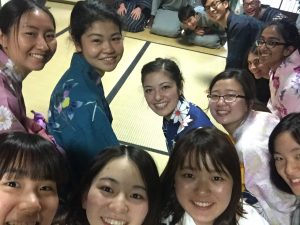
It was great to be able to see all the other U.S. Nakatani at the Mid-Program Meeting! I missed them, their crazy shenanigans and unique late night discussions. I also just missed the comfort of being with American students; I sort of forgot what it was like to not be an outsider to a group after only interacting with the students in the Kageyama lab.
I also had a great time getting to know the Japanese students again! From recommendations about konbini ice cream to conversations about our favorite characters in Attack on Titan, I built on the friendships I made on the Mt. Fuji trip. Especially after talking to a few of Japanese students fairly regularly over Line, it was so nice to be able to chat with them in person. I hope I can continue talking to them, especially when they come to the U.S! I want to be as helpful to them as they have been for me as a fish out of water in Japan.
The tea ceremony and yukata was new experience for me that was hard on my legs, but very worthwhile and a lot of fun. I’m looking forward to wearing my yukata at the Gion Matsuri later this month! I also really enjoyed learning about the history and traditions surrounding the Kamigamo Shrine. I am so thankful that we had the privilege of going on such an amazing and in depth tour. Another highlight of the Mid-Program Meeting was the tour of the Sysmex Techno Park in Kobe, which had a larger impact on me than I expected. After I reflected upon the visit, the concept of an industry-based research career opened up to me. Despite the Nakatani RIES program being an academic-focused research experience, it surprisingly made me aware of other career options as well. With the remaining time I have as an undergraduate student, I will need to decide whether I want to pursue research in an academic or industry-based environment.
One of the most interesting parts of the Mid-Program Meeting was comparing everyone’s different research experiences. I found it interesting to hear about how the Kageyama lab is and how my research experience is different than that of others. I think I’m really lucky that I am getting along well with the other students, despite them being older and much more experienced at research. I also think the professor-student dynamic in the Kageyama lab is special; despite Kageyama-sensei always being so busy, he has time to talk to and advise his students and even takes time to eat lunch them.
Professor Kono, Sarah, Ogawa-san, and Horikawa-san visited the Kageyama lab last Friday. I was a little sad that the timing didn’t work out; because the group came at 9am the lab was uncharacteristically quiet . There was also an oxygen level warning on the door so we had to wait to enter the lab until it was checked. Despite these slight obstacles, I think the visit went well. It was nice to show Sarah and Professor Kono what I have been doing the past weeks.
As much as I am enjoying my experience in the Kageyama lab, it has also been the biggest challenge of this trip so far. When I joined the Kageyama lab, there were so many things that I initially struggled with. Of course, understanding the research enough to explain it was a difficult task. Learning how to use all the equipment independently was also a struggle, and I still am not completely comfortable operating it by myself. There were also social aspects as well; getting to know other students and understanding the lab dynamic was also difficult.
However, especially now that I am a couple of weeks into my internship, things are a lot better. I am understanding the broader concept of my research and am slowly learning the ropes around the lab. I am also a lot more comfortable talking to the others; I eat lunch with a few of them everyday. I think a group of us are going to go on a trip together before I return to the U.S., which I’m incredibly excited for! This past week, we were actually talking about the Tanabata festival, which led to a bunch of the students talking about the various legends and stories surrounding their hometowns. One student even started singing a song about the history of his hometown. This conversation got me more motivated to not only learn about Japanese history, but American history as well. I never really considered the history surrounding my hometown/county. I don’t think there is anything that significant, but when I return to the U.S., I think I will look into it.
Mid-Program Meeting Research Introduction Presentation
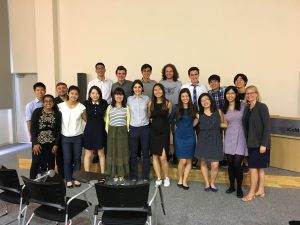
As part of the Mid-Program Meeting, on Monday, July 3 our 12 U.S. Fellows gave a presentation at Kyoto University introducing their research project and future plans. Emily presented on the research she is doing in the Kageyama Laboratory at Kyoto University entitled “Novel Materials for Visible Light Induced Photocatalysts”. Click here to download a PDF of her presentation.
Host Lab Visit
Professor Kono, Sarah, Ogawa-san, and Horikawa-san visited the Kageyama lab last Friday. I was a little sad that the timing didn’t work out; because the group came at 9am the lab was very dead. There was also an oxygen level warning on the door. Despite these slight obstacles, I think the visit went well. It was nice to show Sarah and Professor Kono what I have been doing the past weeks.
Research Project Update
The past week or so has been largely finishing up some last data analysis and preparing for the monthly Kenso. Kenso, short for Kenso Soudan, is an all day meeting where every student in the Kageyama lab presents the research they have done for the past month. After this meeting, Kageyama-sensei, Kato-san, and I had a fairly long discussion about where my research should go from here, which I found really helpful. After this meeting, I actually feel more ready to tackle the last half my research internship and am ready to make the most of it.
Efforts to synthesize Sr(ZnGa)ON have been unsuccessful. With NH3 synthesis, a new starting material of Sr3Ga2O6 was tried, but it didn’t work. Strontium is just so susceptible to reacting with water and Kato-san and I are out of ideas on how to circumvent the problem. Thus, we are going to move onto the high pressure synthesis method, which I personally have more hope for. Last time, by using high pressure synthesis, Sr(ZnGa)ON didn’t form, and rather, SrZnO2, which is a significant improvement. This time, we are going to be using a two-step high pressure reaction, which I will be starting this week.
I’m also starting to branch off and look into other target compounds such as Ba(ZnGa)ON and LaZnON. I have just started the process of synthesizing the starting material for Ba(ZnGa)ON, BaZnO2. As for LaZnON, I have already tried a few trials of NH3 synthesis which have not produced optimal results. Next week, I am going to try a NH3 reaction with a higher temperature. Next week, I’m also going to try a high pressure synthesis.
I’m also going to look into other directions that I could take. Some ideas that were talked about with Kageyama-sensei were LaGeO2N as a target compound, as well as using ZnGeN2 as a starting material for Sr(ZnGe)ON.
Week 08: Research in Japan vs. Research in the U.S.

The Kageyama Lab has weekly cleaning, where usually I choose to help by sweeping and mopping the floor. Recently, after the undergraduate students and other international students have left to study for tests or to go back to their respective countries, cleaning has taken a lot longer than it used to.
I was sweeping the floor absentmindedly, listening to the hum of the furnaces and the chatter of the other lab members. Suddenly, I hear a yell from the other side of the lab; I walk over quickly, thinking there has been a bad spill or the garbage smelled particularly bad, but it was just some of the students holding some stick and pretending to spear something on the ground. Apparently, these things were fishing rods, but no one knows how or why they are in the lab. Taking a break from cleaning, a bunch of the students spent time pretending to fish and joust with one another. One of the usually shy and serious students even used the sharp ends to pose like a monster in Dragon Quest. This strange find had us laughing and goofing off for around for 20 minutes! Such a random event in a routine cleaning event turned out to be one of the most memorable times I’ve had in lab this summer.
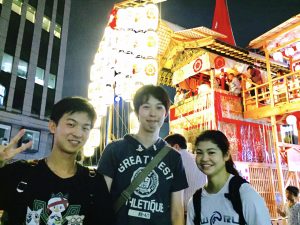
On my first day of research, Kageyama-sensei described his lab as a family. At first, I was pretty doubtful of this statement. I had the impression that the culture of Japanese research would be professional, with the students always relentlessly working and the lab being always relatively quiet. However, this expectation was soon broken, especially since my first day at lab was a department softball game.
At the beginning of the summer, I would always use formal Japanese. After noticing that no one uses formal Japanese in the lab except when talking to a professor, I asked my mentor if I should speak with “desu-masu” style or with an informal style. He replied, “If I can’t speak formal English, you shouldn’t have to speak formal Japanese!”. Even with the masters and doctorate students, I now use informal Japanese. However, I still address everyone with –san, but others use –kun, and sometimes –chan. Everyone, including the some of the undergraduate students, calls one of the lab members “Ma-chan” even though he is a doctorate student!
When people disagree in the Kageyama lab, both parties never seem to get outwardly frustrated or angry. Of course, you can tell that there are conflicting feelings, but they are never aggressive. It is difficult for me to understand the dynamic in an argument because of the language barrier, but I get the sense that if two people cannot agree on something, the “agree to disagree” solution is commonly used. However, I don’t think people argue a lot in lab. Instead, students tend to think together to come up with a solution together, which I really like. I think this approach to solving conflict reflects the overall structure and culture of Japanese laboratories which I wish was used more in the U.S.
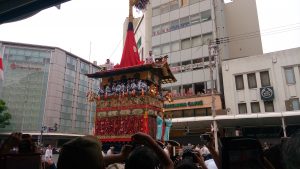
In Japanese labs, people tend to know each other much better than American ones because research is largely graduate-student focused. Students are able to spend more time researching instead of being in class and therefore, spend more time with each other. Because of this, in Japan, other students in your lab may become some of your closest friends. This past weekend, I went to Gion Matsuri with some of the students in the Kageyama lab, including Kageyama-sensei! It was really fun hanging out with them in a different setting and becoming better friends with them. Kageyama-sensei continues to amaze me about how friendly and relaxed he can be with his students.
To be honest, I was kind of surprised that people in lab wanted to go with me; I figured they would all have friends to go with. I originally planned to go to the festival only on Sunday and Monday with some of the other Nakatani students. I ended up going on Friday and Saturday with people from lab! On Saturday, I went with one student who had never been to Gion Matsuri before, or any sort of festival that had been that crowded. It was really fun navigating our way through the crowds together and enjoying that new experience together.
Research Project Update
This week, I continued my efforts to synthesize Sr(ZnGa)ON. I continued using Sr3Ga2O6 and SrZnO2 as starting materials and varying the temperatures. This week I carried out a NH3 synthesis reaction at 700°C, which produced some fairly unexpected results. By holding this temperature for 2 hours, some SrZnO2 formed, along with unreacted materials and Sr(OH)2. This was a positive result. When I analyze my data and look at the XRD, I want SrZnO2 peaks to form that are slightly shifted to the left of the theoretical peaks from substitutes of Ga and N. Since 700°C seemed to be a potentially successful temperature, I decided to hold the system at 700°C for 8 hours to try to prevent impurities from forming. However, instead this lead to any SrZnO2 that may have been formed decomposing to the reactants and Sr(OH)2. Kato san and I have decided to try using this reaction one more time with flux. Flux is a mixture of NaCl and CsCl that may prevent the decomposition of SrZnO2 (that may have Ga and N substituted in it). To use flux, I will put the sample in a crucible and then cover it in the flux mixture, and then put it in the furnace. The NaCl-CsCl mixture will evaporate with the high temperature, only leaving my sample when the reaction is finished. I will also be using the flux technique to try to synthesize LaZnON. So far, I have only gotten unreacted materials or La(OH)3, so I am hoping that the flux will help produce my target compounds.
I am also trying to synthesize Sr(ZnGa)ON by high pressure synthesis. This past week, I started a two step high pressure synthesis reaction. The first step was synthesizing high content (0.75) zinc ZnOGaN solid solution. ZnOGaN solid solution can be synthesized via NH3 synthesis, but only with zinc content up to around 0.3. By checking the lattice parameters and using the Reitveld Refinement techinique, I confirmed that the Zn:Ga ratio was 0.83:0.17. Though this isn’t exactly what I wanted, I still used this sample because for high pressure reactions, the ratio between Zn and Ga doesn’t matter that much. I mixed this sample with SrO and completed the second step of the high pressure synthesis. However, when I was trying to extract my sample from the high pressure cell I put it in, I broke the sample pellet and have to re do this synthesis next week.
I talked to Kageyama-sensei late last week and he told me he wants me to try a “crazy project”: Something that I think of entirely on my own, based on what I think could work. Kageyama-sensei acknowledged that I am young and inexperienced, but he believes the best way for me to change this is to try something brand new instead of being given a project. My task for this weekend and early this week will be to think of this “crazy project”. I’m not sure how this is going to go, but it’s worth a shot. Besides, regardless of the results, I agree with Kageyama-sensei that it will help me become a better researcher and understand what research is all about.
Return to Top
Week 09: Reflections on Japanese Language Learning
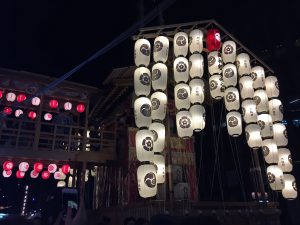
During the first 3 weeks in Tokyo, I was able to focus on studying Japanese. I learned a lot of new grammar, vocabulary and how to introduce myself well (which was very useful for the beginning of the research internship). After a first few days of anxiety, I was more open to practicing my Japanese with native speakers, such as asking strangers for directions and talking to store employees. Although the Japanese I learned in class has no doubt helped me, talking to others in Japanese has helped my communication abilities significantly (even if they are broken).
The research experience in the Kageyama lab is amazing. Of course, the research is interesting and the skills I am learning will be invaluable for my future. However, it’s the people I see and work with everyday that play a large role in my experience in the lab. During casual conversations about our weekends or short daily exchanges while walking around the lab, I try my best to use Japanese with the others, to which they usually respond in English. My Japanese abilities are significantly worse than all of their English abilities, but I think this mixed language exchange helps both parties get better at each other’s languages. I really appreciate everyone’s patience and ability to understand my broken Japanese. I am especially thankful for my mentor, Kato-san, who I talk to the most and have the hardest conversations with.
When I’m at lab, there are some times when I just need a break from thinking and doing research. I’ve found that the most productive way to make use of this time is to study kanji. At first, I studied from a textbook, but this became a little boring. I have now made it a goal to learn the kanji for everyone’s name in the lab. Learning the meaning behind everyone’s name has been much more interesting; my favorite is “small forest, peaceful ocean”. I always enjoy finding out if the person has a personality similar to their name. One amusing inconsistency is a name that means “inside pond, courage”, but the student cannot swim. The fact that I’m making an effort to learn Japanese seemed to surprise many people. I’m not sure, but maybe because I am trying to learn everyone’s native language, they are more open and willing to get to know me.
I have been practicing Japanese a lot, but I still am no where near a place of being able to live my life in Japanese. Earlier this week, I called a store to get my phone inspected for a battery problem. The store employee spoke very fast and I barely understood anything at all. Based on my responses, I think it was fairly clear to the employee that I was not a native speaker and was very confused. I thought I made an appointment for 9:20am the next day, but it turns out I misheard the time, despite repeating it back to him. The appointment was supposed to be at 10:20; the store wasn’t even open until 10. This is just one of the many times of when I am reminded that my Japanese has a long way to go.
Before I came to Japan, I wanted to learn Japanese for my heritage and the sake of knowing a second language. However, after making many new Japanese friends this past summer, I am more motivated to improve my Japanese so that I can become better friends with them and make it easier for us to communicate. Now, by being around native speakers all the time, I can ask people better questions about spoken Japanese! Inevitably, I won’t have native speakers as a resource around me all the time who can answer questions about colloquial Japanese that you wouldn’t learn in a textbook. For example, Kato-san taught me the word for the notoriously horrible “middle school phase” most teenagers go through (chunibyou). We both found it hilarious that this problem exists in the U.S and Japan (from our own personal experiences). Once I get back to the U.S., I will have to make much more of an active effort to improve my skills and not forget the ones I’ve attained this past summer. I plan to take a Japanese language class in the spring semester, but this fall I think it would be a good idea to expand my vocabulary and knowledge of kanji.
I would also like to keep in touch with the Japanese Nakatani students and the students in the Kageyama lab. If I can occasionally email them or message them in Japanese, I think that would help me immensely. I would be able to improve my Japanese, but more so sustain the friendships I’ve made this past summer.
Research Project Update
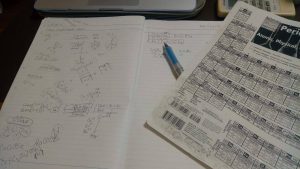
This week, I tried to synthesize Sr(ZnGa)ON with NH3 synthesis with flux. I tried using flux by myself but I think I made a mistake in the process and am going to be doing this reaction again. The crucible seemed to have the sample in it with the flux crystallized over it, which was fine. I tried to just chip off the CsCl-NaCl mixture, but I could not chip it deep enough to get to the sample and I ended up just taking an XRD of CsCl-NaCl. I washed the crucible in water to dissolve the salt mixture and then filtered and dried my actual sample. However, I’m guessing in the process of dissolving the flux, the sample itself reacted with the water; the XRD produced was largely Zn(OH)2. I’m going to ask Kato-san and make sure I do the correct process this time so I can use flux properly.
I also tried to synthesize Sr(ZnGa)ON again with the two step high pressure synthesis. After making a mistake when I broke the sample pellet, I have been extra careful. I did modify the the first step by raising the pressure in hopes to get a purer solid solution of ZnO-GaN. Unfortunately, increased pressure did not really have an effect on the purity. In any case, it is pure enough, so I will continue with the second step of the synthesis by mixing this solid solution with SrO.
I have also started my “crazy project”, after talking to Kato-san and Kageyama-sensei for 2 hours earlier this week. We all acknowledge I do not nearly have enough time to be able to actually complete this project, but it is very interesting nonetheless. I’m currently investigating how to create SrTiONF; if I actually could succeed and synthesize this, it would be incredible. So far, I have tried using TiO2 and SrF2 with NH3 synthesis, which I have yet to analyze. One thing that was very noticeable however, was how two white powders turned black – this is probably due to the reduction of TiO2. What is most important about this project is that it’s much more independently thought out than my main project, which I think will help me become a better researcher.
Week 10: Interview with Japanese Researcher
This past week, I ate dinner with two students in my lab and we talked about our plans for the future. One of the students I talked to is a first year master’s student who also studies visible light photocatalysts. His main motivation for his research is creating an environment based on renewable energy. I found out that he is actually just started studying in the Kageyama Lab this past April and wants to continue until to a doctoral course. So far, he’s really enjoying his experience here. We both think that everyone in the lab is very nice, and that students and professors are very patient when they are teaching others.
When I first met this student, I thought he was a Japanese student because he is able to speak Japanese fluently; he even gives his research presentations in Japanese. However, he’s actually an international student from Shanghai and knows Japanese because he lived in Japan for 5 years. Unlike me and the French international students, I don’t think many students really consider him an international student. However, he told me despite his language abilities, he is new to being a Japanese student and told me he is still trying adjusting to life here. He is currently very busy writing reports for all his classes, as well as making a poster for an upcoming conference.
We talked a little about America, which turned out to be the most interesting part of the experience. He’s never been to America, so it was hard for him to compare the lab culture between Japan and America. The only guess he had about the differences was that American researchers wear lab coats while experimenting and that American lab culture is more reading focused than Japanese research. Culturally, he said he’s interested in American basketball and mentioned Lebron James as a particularly cool player. He was pretty disappointed when I told him that I never took the opportunity to see Lebron play, even though I spent a whole year in Cleveland. He also asked me if people really eat Chinese food in America very often. He explained that on Big Bang Theory, the characters eat Chinese food once a week. We then looked at American-Chinese food and he was very confused.
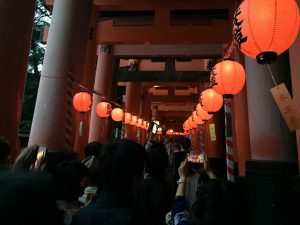
After eating dinner with these two students, we went to the Motomiya-sai Festival and Fushimi Inari Taisha. It was much less crowded than Gion Matsuri, but just as hot and humid. The festival takes place at night, where the gates have hundreds of lanterns that are lit up all around the shrine with people dancing, singing, and eating all around the area. The taisha is located at the base of Mt. Inari, which can be climbed by a path that is surrounded by lit up gates. We climbed the mountain to a viewing point where we could see a great night view of Kyoto.
Among the Nakatani students, my spirit animal is considered to be a deer. Before I went to Nara, I didn’t understand where this was coming from. After my trip to the infamous deer park, I can see some of myself in the deer; usually evasive of people, except when they’re offering food. In seriousness, the deer in Nara did not react at all to the people around them and simply minded their own business. However, if they saw that a tourist was holding rice crackers, they would chase after them and hoard them until they got to eat them.
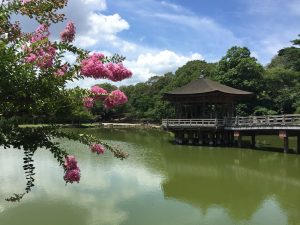
While in Nara, I also visited Kasuga Taisha and Todai-ji. Todai-ji was really impressive and I even tried my first “okumiji”, or fortune, and I got the second best fortune! One part of the fortune that I really think relates to my current situation is “It will be found after you have given up”. I hope that this means once I give up synthesizing my target compound, it will eventually be created. Since I’m leaving Japan very soon (I don’t want to accept it), I’ll be forced to give up, so maybe my target compound will be discovered! It’s also (likely) possible that this fortune means nothing.
In Nara, I got to see another ukimido, similar the one I saw when I visited Shiga Prefecture. I think I’ve decided that they are my favorite architectural structure ever. After a ton of walking, I rested in the “floating pavilion” for ~45 minutes and enjoyed the shade and slight breeze. There weren’t too may other people there and it was a very relaxing, introspective experience.

My week finished with a nice, late night dinner with 2016 U.S. Fellow Erica Lin. Both of us had different travel plans and busy lab schedules this past month, so we hadn’t seen each other in a few weeks. We both recapped our lives with topics ranging from our research and how there just isn’t enough time, to our impressions of Gion Matsuri, to the best food we had eaten. We both are extremely sad to be leaving Japan and can’t believe the summer flew by so fast. I can’t believe that soon I’ll be back in Houston, then NY, and then off to start the fall semester.
Research Project Update
Flux is a mixture of NaCl and CsCl, which can be dissolved by washing the heated sample in water, leaving only the desired sample in the crucible. Once it is dried, it can be tested. This past week I faced a major setback; I found out that both my starting compounds of SrZnO2 and BaZnO2 are not stable in water. I also tested the La2O3 + ZnO reaction with flux, and the XRD showed peaks resembling La(OH)3. Thus, I cannot use flux as a way of “protecting” the samples from reaction with water in the air.
From here, Kato-san and I have decided to give up trying to synthesize my target compound via NH3 synthesis and give it one last try with high pressure synthesis. However, I have also had a lot of problems with high pressure reactions. This is mostly due to my own mistakes, but also due to the machine as well. What is difficult about the high pressure reaction I am trying to do is that it requires two high pressure reactions every time. The first step is synthesizing high content ZnO-GaN solid solution and the second step is combining that solid solution with SrO. Each time, approximately .25g of ZnO-GaN can be produced, which is just enough for the second step. Thus, if and when the desired result from the second step is not achieved, the process must be started over from the first step (ZnO-GaN must be synthesized again).
The first time I tried this two step method, upon extracting the sample from the cell, it crumbled and because there was such small amount of powder, I could not analyze it with an XRD. Thus, I started over from the first step, successfully making ZnO-GaN again. However, during the second step when I made a new cell with SrO and ZnO-GaN, the machine malfunctioned and the temperature didn’t increase. Unfortunately, the cell cannot be reused so I must start over and try this reaction one more time.
As for my alternate project of synthesizing SrTiONF, I tried two NH3 reactions starting with TiO2 and SrF2 at 800°C and 900°C. Both resulted in black powders, which resulted from TiO2 being reduced. Unfortunately, the two reactants did not combine, so I will try increasing the temperature.
I also thought of a new method of synthesis that starts from heating TiN and SrF2 at a relatively low temperature of 400°C. The main obstacle with starting with TiN is that it will oxidize to TiO2 at 450°C, so a temperature above that cannot be used. However, such a low temperature is unlikely to allow substitutions and synthesis of the reactants.
Return to Top
Week 11: Critical Incident Analysis – In the Lab
This past Friday, Kyoto University’s Katsura campus had a “beer garden”, which was a mini festival where all the labs on the Katsura campus came together in the center of campus to eat, drink, and socialize. I got to know everyone more, which was especially easy after they had drank a bit of beer and were a little more relaxed than normal.
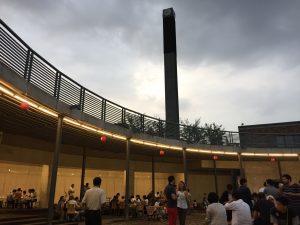
The purpose of the festival was to give the 4th year undergraduate students a break from studying by giving them time to relax and some free food. Currently, all the 4th year students (B4) in the Kageyama Lab are studying really hard for the entrance exams to be able to continue studying at Kyoto University for graduate school. I haven’t heard from most of the Kageyama Lab B4 students for about a month. However, I didn’t know that this was the purpose of the festival until the last minute. The email I received about the festival just noted the different fees depending on what year you were, and that B4 students were free. I assumed that since I’m a B2 student, I wouldn’t have to pay to go. However, earlier this week, one of the students in my lab approached me and asked me to pay 2000 yen for the festival. I was confused; why would I have to pay money to go to an event when I can’t even drink? At the time, I just thought it was a beer festival with no food (the fliers had cups of beer all over them). I was a little hesitant to pay 2000 yen just to walk around campus with everyone.
An awkward exchange began between me and this student. I tried to ask the student what exactly my 2000 yen would be going toward; beer, an entrance fee, or something else. However, I tried to get him to explain without explicitly asking, since it would be pretty rude to blatantly ask “Why do I have to pay money to go to an event where I won’t drink?”. However, it was clear he wasn’t understanding what my confusion was with my subtle English hints. Unfortunately, my Japanese isn’t good enough to try to break the language barrier. Of course, I paid, but because of our conversation, he started to get the impression that I didn’t want to go and that I was succumbing to peer pressure (which wasn’t true, I genuinely wanted to go, but was just confused).
Everything made sense when he said “I think it would be fun to celebrate the B4 student’s studies”. It was then when I realized that the B4 students were free because they were the purpose of the festival. I felt so guilty and idiotic and apologized for my confusion. I don’t know if he ever understood what I was confused about, but at least now the situation is resolved and we both had a lot of fun at the festival.
I also enjoyed my last full weekend in Kyoto by walking around the city and absorbing the city vibe. I have really come to like Kyoto more than I expected. While I was in Tokyo, everyone told that it’s a beautiful city with horrible weather. They’re completely right; Kyoto is beautiful and you feel like you’re swimming if you stay outside for more than 20 minutes because it’s so humid.
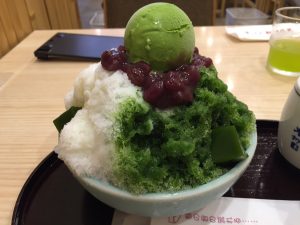
A few weeks ago, I passed by a cafe specializing in green tea products but had a very long wait. I decided to go back this Saturday at 10am so I wouldn’t have to wait, since people do not really eat ice cream and matcha parfaits in the morning. Thus, I ate kakigori (shaved ice) and ice cream for breakfast (a definite first for me), which filled me up for the whole afternoon. I also walked around the Gion area which has a lot of traditional shops. My favorite was a senbei (cracker) shop, where I bought some thank you gifts for the Kageyama Lab. I can’t believe this week is the last week of my internship; I’m so sad that I’m going to have to leave Japan so soon.
Research Update (1 – 2 pages)
This past week, I continued to think about how I could synthesis SrTiONF. I tried a few NH3 reactions, but SrF2 is stable (melting at 2000°C), so my mixture remained unreacted. I also considered starting fron TiN and SrF2 instead, but there also exists a problem with that as well. TiN will oxidize at a very low temperature of ~450°C, so the oxidation state will change and not be able to form SrTiONF. I think I will have to read more papers and think of different reactants in order to synthesize this compound.
I also (finally) managed to complete my two-step high pressure synthesis reaction! The most interesting thing about the sample was that it changed from light green to a dark pink. This could mean that the reaction occurred, or that there were impurities. I really hope it’s the first one. Unfortunately, I learned that the pink color means that the substance probably has a large band gap and cannot be a visible light induced photocatalyst. However, I think it would still be interesting to measure it’s photocatalytic activity in my last week in the lab.
I took an XRD of the sample, which showed peaks similar to ZnO-GaN, which is a positive result. There also seemed to be a lack of SrO peaks, meaning that Sr could have substituted! However, when I checked the lattice parameters, they didn’t change very much. The strontium couldn’t have just disappeared, so I’m pretty confused what happened. Right now, Kato-san is travelling but he will be back soon, so he can help me analyze the data. I also want to know the reasoning behind the significant color change. I talked to Kageyama-sensei and he thinks that there was no substitution based on the lack of change in the lattice parameters and the fact that the XRD did not shift significantly. However, I talked to another student in the lab who also studies photocatalysts and we are both in agreement how it’s strange that there are no SrO peaks. I am excited to see what Kato-san thinks once he comes back.
This coming week, I’m going to run a few last ammonia synthesis tests and conclude my analysis on my two step high pressure reaction. After that, I’ll finish my poster and prepare for the Kenso I have on my last day of lab.
Week 12: Final Week at Research Lab
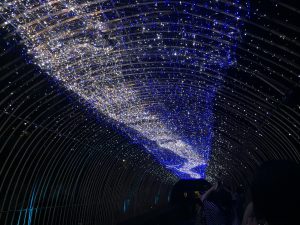
These past few days, I’ve woken up with that strange feeling you get when you are doing something unfamiliar. I never expected to adjust to life in Kyoto as well as I did. Now, it seems as soon as I had adjusted, I’m heading back to Houston, my project with results that don’t really make sense, friends that already seem a world away, and fall semester approaching quickly.
After this summer, I think the biggest thing that has changed about me is my appreciation for the small things. I clearly remember the smell of when I walked down the street toward Byodoin in Uji; the whole street smelled of freshly ground matcha. I can never forget experience I had gazing out on Lake Biwa, the only sounds being the rustle of grass and the small waves crashing on the rocks beside me. When I get back to America, I’m going to look for and appreciate these little aspects in life that used to forget about.
There are so many things I will miss about Japan, but maybe the thing I will miss most are the friends I’ve made. The hours and hardships of research can really pull a people together quickly. I doubt they will ever realize it, but the other students in the Kageyama Lab made my experience in Japan so much better. I also loved hanging out with the other Japanese Nakatani Fellows, all of whom are great and interesting people. This past summer, I struggled with the language barrier and I think it made friendship and communication with my mentor about my research more difficult. I want to improve my Japanese abilities so I can maintain the friendships I’ve made this past summer.
I am really sad to be leaving Japan, but there is a small part of me that is glad to be going home. In fact, after this summer, I’m a little prouder to consider America my home. I’ve heard from several people that they are jealous of my fluency in English. I’ve always taken this for granted and thought it was nothing special. But this past summer, I actually realized that despite my age and inexperience, I did have one advantage over others in my lab. Kageyama-sensei requires all presentation slides and monthly reports be written in English because he believes in order to become a successful researcher, you have to be able to communicate with people all around the world (which I agree with). I also see people in my lab who are writing papers who have written them in Japanese and then are slowly translating them into English. I didn’t realize it, but knowing English is actually pretty helpful.
I have also come to appreciate the diversity of the US. Until I have been in such a uniform country like Japan, I didn’t actually realize how diverse the US is. In the US, I’m eating all types of different foods and hanging out with friends from different backgrounds all the time. This past summer, I kind of missed that aspect of American life; I love rice, but sometimes I really just want to eat a taco and a bowl of macaroni and cheese.
Final Week in Research Lab
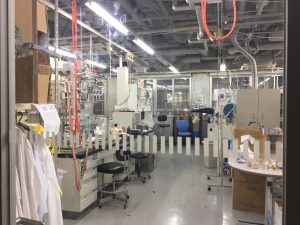
My final week at lab was a whirlwind; it was like finals week of spring semester. Maybe worse. I got up at 6:00am for the first 3 days to finish some last-minute experiments, which turned out to produce some pretty interesting results. However, with all the reports, presentations, and poster due at the end of the week, Thursday was a whirlwind of analysis and confusion, and I ended up staying up really (really) late finishing everything. However, I actually really liked my final busy week but am sad I’m not going to be able to finish analyzing my results. I’m hoping that once my mentor finds some time, he will be able to look into my results a little more.
Overall, I enjoyed researching solid state chemistry and am looking to do similar research when I get to back to the US. Photocatalyst research is presently focused more present in Japan and I don’t think there are any labs at my home university conducting photocatalyst research. I don’t really mind; I want to expand my knowledge and learn about other types of research.
This past summer has been one of a lifetime. I never imagined I’d be able to experience so many things and meet so many people in one summer. I don’t know when, but I’m definitely going to come back to Kyoto one day; I miss it already.
Week 13: Final Report
Final Research Project Overview

Novel Materials for Visible Light Induced Catalysts
“Exploring Zn-Based Visible Light Induced Photocatalysts” (PDF)
This past summer, I had the privilege of being able to conduct research at Kyoto University in the Department of Energy and Hydrocarbon Chemistry. I was a member of the Kageyama Laboratory, which focuses on synthesis of new materials in categories such as superconductivity, photocatalytic activity, and ferroelectricity. My research theme was “visible light induced photcatalysts” and I was mentored by Kato-san, a second year master’s student pursuing a PhD next year.
Climate change is a problem that can be fought with alternative energy. Hydrogen energy can be produced by reducing and oxidizing (“splitting”) water and then collecting the H2 gas produced. However, this process is thermodynamically unfavorable. To be able to be used as a commercial method to produce H2 gas, the help of a catalyst is necessary. Specially, a visible light induced catalyst, or a compound that will easily facilitate the reduction and oxidation of water. In order to be a visible light induced photocatalyst, the band gap of the compound must be less than 3.0eV. Mixed anion compounds tend to have small enough band gaps to be potential visible light induced photocalysts
The central concept of my research begins from ZnO-GaN, a solid solution with a wurzite structure and narrow band gap. Wurzite structured compounds are tetrahedrally coordinated; however, much of the research currently being conducted within the photocatalyst field focuses on perovskites. Thus, investigation of compound with tetrahedral coordination will prove to be interesting for the future of photocatalysts.
Kato-san and I based my target compound on SrZnO2, which has tetrahedral coordination. By substituting nitrogen into some of the oxygen sites, it may be able to function as a visible light photocatalyst. I mainly explored how to successfully synthesize this target compound, Sr(Zn(1-x)Gax)O(2-x)Nx,, but also explored the a new compound of LaZnON. I did this through two techniques; NH3 synthesis and high pressure synthesis.
I first tried using SrO as a starting material, but changed course due to its susceptibility to react with water. After, I used Sr3Ga2O6, SrZnO2, and Ga2O3 as starting materials for NH3 synthesis. I tried various reaction conditions. 800°C and 900°C resulted in indistinct and unclear peaks. Synthesis at 700°C produced the most distinct peaks. However, from the XRD, it is ambiguous whether Sr4Ga2O7 or SrZnO2 formed. I also found it interesting that with longer heating time, the peaks became less defined.
My most interesting results came from my high pressure synthesis reactions.
I first tried one high pressure reaction by combining SrO, ZnO, and GaN, and from the XRD, I believe SrZnO2 formed. However, the lattice parameters did not change and it is likely that no substitution of nitrogen occurred.
I then tried combining ZnOGaN (3:1) and SrO via high pressure synthesis. ZnOGaN with a zinc concentration of higher than 0.3 cannot be synthesized via normal NH3 synthesis. This reaction required two high pressure synthesis reactions; the first two synthesis high Zn-content ZnOGaN and the second to combine that solid solution with SrO.
Mixed phases of SrZnO2 and ZnOGaN were obtained with a few impurity peaks. What was most important to note was the lack of SrO peaks in the XRD. But, I checked the lattice parameters were checked against the starting material of synthesized ZnOGaN and they did not deviate significantly from the starting parameters. Thus no substitution could have occurred into SrZnO2 to form my compound.
However, Kato-san and I were confused what had exactly happened to my sample, particularly due to its color change. It went from dark green to rose pink; thus, some reaction should have happened. Due to pink colored samples tending to have smaller band gaps, we took absorption data was taken to analyze the band gap of the pink sample compared to that of ZnOGaN.
The band gap of 83:17 ZnOGaN is ~575nm, which is logical due to the slightly higher Zn:Ga ratio obtained upon synthesis (83:17). However, the band gap of the sample I synthesized was ~675nm. This is a significant difference; ZnO-GaN needs to have a band gap of at least 600nm for commercial use.
Due to the strange results, I believe that the two-step high pressure reaction requires much more further investigation. Specifically, these three concepts need to be investigated further:
- The reasoning behind the color change of dark green to pink
- Confirmation and justification that the synthesized compound’s band gap is actually smaller and greater than 600nm
- The phase of Strontium within the synthesized sample
SrO’s effect on ZnOGaN should be investigated by conducting reaction 4 without SrO at the same conditions. In addition, further analysis via SEM EDX should be done to analyze the Sr phase within the sample. Lastly, this reaction should be done at more reaction conditions. By understanding the concepts behind the synthesis of Sr(Zn(1-x)Gax)O(1-x)Nx, knowledge regarding tetrahedral compounds as photocatalysts will be expanded.
Follow-on Project Plan
For a follow on project, I was thinking of participating in a study abroad fair this coming semester. I haven’t heard when this will be, but I will contact the study abroad office soon. If the details work out. During the fair, I would like to highlight how unique it is for a program to be geared toward freshmen and sophomores in STEM majors. I can also talk about my summer was from both a cultural and academic perspective.
I think there was a Nakatani fellow last year at Cornell – I could ask her what she did for her follow project and gain ideas from there. I am a new student at Cornell and do not know about the specific opportunities to share international experiences Cornell has to offer.
Another option is to present my research at a conference or campus colloquium. I think I will apply to the Gulf Coast Undergraduate Research Symposium, but I don’t think Cornell will give me funding to fly to Houston so I’m not sure whether that will work yet. I need to do more research on presentation opportunities within Cornell.
Tips for Future Participants
Pre Departure:
- Make sure you can read/write hirgana & katakana well. Knowing some basic kanji (days of the week, numbers) is also helpful too. This can make traveling easier. If you have more time, practice speaking too – you can become better friends with your lab if you can speak a little!
- Do not pack too much clothing or shoes. I went in with this misconception that people wore nice clothes to lab and that I would need many different sets of clothes. I ended up only alternating between a few different shirts and pants. In my lab, people just wore tshirts/casual pants/shorts, so no need to bring nice clothing for lab. You will hate yourself when you are hauling your heavy bag to and from the train station that is 80% clothes.
- Do research on what you want to do. The summer flies by, especially with how busy research gets. Know what you definitely want to see in Japan and make plans to make sure it happens!
- Get some comfortable walking shoes and a hat. Sightseeing requires walking. Japan is hot. Be prepared and don’t get heat stroke! Japan has a lot of beautiful nature to see, which requires being outside for hours at a time. If you’re in the Kansai region, be prepared to be sweating the minute you step outside (but it’s worth it because Kansai is the best).
- Learn some Japanese. Trust me. It helps.
Orientation Program in Tokyo
- Beware of airplane food. I’m guessing you already know this, but it actually made me pretty sick going over.
- You get as much as you put into language class. 3 weeks of language class is a lot and it sometimes gets tough. Remember that it’s only going to help you later and you should pick up and learn as much as you can.
- Try to use Japanese as much as possible. Whether it be asking for directions, ordering food, or buying things, take all the practice you can get.
- Plan out your weekends in Tokyo to the max, especially if you aren’t going to be in Tokyo the rest of the summer. There’s no way you can hit everything in Tokyo, but good planning helps.
- Plan out your routes ahead of time. This will save money and a lot of confusion (especially with the subway system).
Mid-Program Meeting in Kyoto
- Discuss openly with the other students about your research experience. Whether your research is going how you want it or not, it’s always good to compare and see how you can improve your experience and just reflect on the past 4 weeks.
Working With Your Lab
- They’re busy, but not as busy as you think. Yes, your fellow lab mates are masters students, incredibly smart, and busy with research. But don’t be afraid to talk with them. They are nerds in their 20s – you probably have lots of common interests with them. You may feel like you’re bothering them, but at least some of them will want to get to know you too (you’re from America…that’s pretty interesting after all). Don’t forget they’re human and probably really cool people!
- Read some papers and background on your research. This is probably obvious, but make sure you read through and understand the theme what your lab does. Your research may just be a small part of the overall lab’s goal. Understanding the theme of your lab is really important to doing great research.
- Show interest in others. Not in a creepy way. But ask about their lives! You’re in the lab for research, but it’s also an amazing opportunity for cultural exchange.
- Friendships come slowly. I was worried that people in my lab didn’t really want to talk to me for the first few weeks I was there, but it just took time. Even if you are shy, don’t be afraid to take initiative and talk to others.
- If they ask you to go out, go with them. It will be fun, I promise!! But if they ask you to drink and you don’t want to, don’t be afraid to say no. Usually, they’ll just tease you for being young.
- Make friends in your lab. It’s so much less awkward to ask for help from someone who you just hunted pokemon with on campus than a guy you have never talked to who is writing his thesis.
- Don’t get frustrated when things aren’t going right. Things do not go right in research (at least, 90% of the time). That is okay. Just keep going; perseverance is the most important thing. Regardless of your results, you will gain so much from this summer.
Living in Kyoto
- Buses are confusing. The Kyoto bus system is confusing, but you’ll get it eventually (probably). You’re going to have to use it to sightsee around Kyoto – just try to map out your route beforehand. With time, you will become more familiar with the city and able to figure it out.
- Don’t be afraid to ask people for help. People are nice and willing to help! Just politely ask for some directions – I had someone walk me to a bus stop once.
- Green tea. Just, please. Drink it.
- Sometimes, buying drinks/bread from supermarkets is cheaper than convenience stores. If you live near a supermarket, check out the prices!
- Gion Matsuri is awesome. Go one or two days! It’s so crowded but a really cool experience. Go with other students/people in your lab, it makes it a lot more fun.
- Kyoto is the best. I was pretty indifferent about living in Kyoto relative to other cities in Japan before the program, but I quickly realized I was in the best place ever. It’s absolutely beautiful – surrounded by mountains and packed with historical monuments, shrines, and temples. Osaka, Uji and Nara are very close so you can make day trips. Shiga Prefecture’s Lake Biwa is also very close. It’s slower than Tokyo with a much more relaxed atmosphere. It’s now one of my favorite places ever.
Language Study Tips
- Know hirgana and katakana. You gotta.
- Talk to people. This is the best way to get better at Japanese. Ask questions about Japanese. People in your lab are happy to teach you! They all took Japanese grammar in middle school and will know what you’re talking about when you ask about u-verbs versus ru-verbs. Even if you are shy/embarrassed, you can do it!
- Do as much Japanese studying as you can before you leave for Japan. You are jetlagged/busy during Tokyo, and busy during the research internship. Study hard ahead of time!
- Focus on speaking skills when in Japan. When you’re in Japan, that’s when you’re going to be able to improve your speaking skills the most. You can work on vocabulary and kanji when you get back to the US – or before you leave 🙂
- Make a good effort. The more Japanese you know, the better. The language barrier is tough, especially socially. Research is so much more fun when you are friends with the people around you.
Other Tips
- Enryakuji and Mangetsu-ji. This was my favorite day trip I took the whole summer. Enryakuji is a monastery on top of a mountain and you can see Lake Biwa. Mangetsu-ji has a “floating pavilion” that sits on top of Lake Biwa. It’s a bit far, especially Mangetsu-ji, but totally worth it if you love nature. If you were to pick one, definitely go to Enryakuji – Mangetsu-ji is far and in a random suburb along Lake Biwa.
- Buy some clothes. Japanese clothes are pretty interesting. Even if you’re not into clothes, take a look.
- Go to festivals and see some fireworks. They are the coolest things ever. Make sure you get to at least one before you leave. I actually didn’t get to see any big fireworks displays and I am so sad. Something to do next time I return to Japan 🙂
- Unless you really want to, don’t wear geta. I wore geta to Gion Matsuri one night. I died, but now at least I can say I did it. If you want to try, go for it – just know that it definitely isn’t the best walking shoe in the world (may be one of the worst, to be honest). I would suggest wearing your yukata though! It makes you feel the part.
- Brave the heat. You have to go outside to see the best of Japan. It’s hot, but you can do it! Take sight seeing slowly and it will be okay. Drink water!!!
- Be aware of special transportation passes. Slower Shinkansens are cheaper. The Kansai Thru Pass is the best thing ever for going on day trips in the Kansai area. The Kyoto City Bus Pass is pretty helpful as well. There are others and most of the information can be found online – they will save you so much money.
